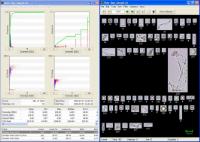 Add My Company
Add My Company
Sign In

Particle Counters Resolution and Sampling Issues Among the many particle counters and other instruments available for particle analysis today, those attracting much of the analysts current interest are the imaging particle analysers. Combining the speed of an automated particle analyser with the discrimination of an optical microscope, their technology can be used to determine shapes as well as sizes and counts. There are limitations, however. As we will see, under some circumstances the imaging particle analyser is little more than a particle counter. A particle analyser traditionally shows the distribution of particle size in a sample and at the same time acts as a particle counter. In imaging particle analysis the particle characterisation goes much further, giving size, shape and grey-scale information on the range of particles present but only if the required level of image resolution can be achieved. Resolution refers to the ability to capture and output information. For the purposes of this article we will ignore output resolution and focus on input resolution. A common example of the difference between them is the clear image on a computer screen, with an input resolution of 72 pixels per inch, which becomes blurry when printed onto paper because the output resolution required for the same clarity is 300 pixels per inch. The limitations of resolution in an instrument are determined by the optical system and the sensor. In human terms, spectacles are an optical system and the eye is a sensor. In fact, the human eye, with its millions of rods and cones, is a remarkably good sensor, roughly equivalent to a 6 to 7 megapixel colour and 120 megapixel black-and-white digital imaging device. Whats more, our brain removes all pixelation to create a perfectly smooth image every time. In describing resolution, we often use the same terminology as in photography. The term line pairs per mm indicates the ability to distinguish closely spaced, parallel, black lines (interspersed with white spaces of equal width) as being separate. In a film system, the film itself is the sensor. In a digital system, the sensor is a rectangular grid of photosensitive picture elements or pixels. Each pixel outputs a signal which depends on the amount of light it receives. The spatial resolution limit of the sensor in a digital system is normally determined by the sensor itself, as its number of pixels is finite. To determine that limit, one of the easiest methods is to use a test target and see what is the largest number of line pairs per mm that the system can distinguish. Each pixel can be given a value, which is often an 8-bit number. Black is given the value 0, white is 255 and the many shades of grey are denoted by the numbers in between. For simplicity, we will ignore colour images here. The resolution of the sensor is fixed by the number of pixels, while the systems overall resolution is also affected by its optical magnification. To determine whether a pixel represents part of a particle or not, the associated software compares its grey scale value against that of the background that would be seen if no particle was present. If the difference is sufficient, it is accepted as being part of a particle. The shape of the particle, as seen on the screen, depends hugely on the density of the pixels. In digitisation, a continuous (or analogue) signal or image is converted into a set of points. This is known as sampling. A key concept in this area is the Nyquist-Shannon sampling theorem. This says that to obtain accurate reproduction of a continuous signal with a particular frequency, the sampling frequency must be at least twice that number. In digital imaging, the theorem states that at least two samples per cycle, and two pixels per line pair, are needed. In practice, most microscopists advocate a rate of between three and ten samples per object to achieve the necessary resolution. Although line pairs are a useful reference point, the shape of a particle is much more complex. So, for example, a system capable of resolving one line pair per micron may be used to measure spherical particles with a diameter of 1 µm or above, but obtaining more detailed information on complex-shaped particles would require greater resolution and a higher sampling rate. To the limiting factors mentioned above, we must add imperfections in the optical system. These can be reduced by using very expensive equipment and by correction methods, but even the best system will be limited by a further factor: diffraction. Diffraction results from the wave-like nature of light. The behaviour of light waves is affected by objects, such as the aperture, and by travel from one material into another, such as the passage from air into glass. Its effect is to limit the sharpness of the image. The Numerical Aperture of an optical imaging system, which takes into account diffraction and also the wavelength of light used, is an indicator of its ability to resolve fine detail. A case study covering all of the considerations above can be provided by Fluid Imaging Technologies, Inc. Its FlowCam continuous imaging particle analysis system was used on a sample containing particles whose Equivalent Spherical Diameter, or ESD, was less than 10 µm. Using the instruments software to filter and isolate particles with an ESD of 1 µm, a series of nine images was produced. Particles of that size proved to be too small to discern any detail when viewed at 1:1. When magnified to 64X, simple blocks of pixels could be seen. Repeating the same process with particles of 4 µm ESD, and viewing at 64X, produced very different images in which it was clear that, for example, some were spherical and others were rod-shaped. In conclusion, if an imaging particle analysis system is to be used as a particle counter, it should be applied only to particles with an ESD of 1 µm or above. If the ESD is 2 µm or more, the system should be able to offer simple particle characterisation, such as distinguishing between spheres and rod shapes. When particles have an ESD of at least 4 µm, characterisation to a higher level is possible, including measurements such as circularity.
For more information on Particle Counters Resolution and Sampling talk to Meritics Ltd
Enquire Now
List your company on FindTheNeedle.

